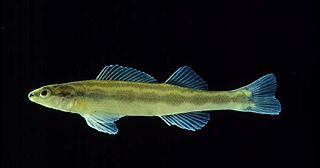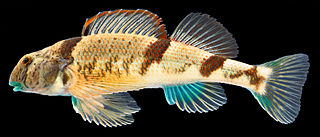
The goldline darter is a small species of freshwater ray-finned fish, a darter from the subfamily Etheostomatinae, part of the family Percidae, which also contains the perches, ruffes and pikeperches. It is found in the United States, primarily in the Cahaba River in central Alabama and the Coosa River in Georgia and Alabama. It is a small fish seldom exceeding 3 in (7.6 cm) in length. It is typically found in areas with moderate to swift currents and a water depth of over 2 ft (60 cm), in the main channels of free-flowing rivers with a rock, cobble or boulder base and aquatic plants. It has been federally listed as a threatened species since April 22, 1992, and the International Union for Conservation of Nature has classified its conservation status as being "vulnerable".

The Roanoke logperch is a species of freshwater ray-finned fish, a darter from the subfamily Etheostomatinae, part of the family Percidae, which also contains the perches, ruffes and pikeperches. It is found in the Roanoke and Chowan drainages in Virginia and North Carolina in the United States. It inhabits low and moderate-gradient streams and rivers in warm, clear water in mostly unsilted gravel and rubble in runs, pools, and riffles. It is primarily insectivorous. This fish is a federally listed endangered species.
The coldwater darter is a species of freshwater ray-finned fish, a darter from the subfamily Etheostomatinae, part of the family Percidae, which also contains the perches, ruffes and pikeperches. It is endemic to the United States, where it occurs in the Coosa River system of Georgia, Alabama, and Tennessee.

The sawtail grouper is a species of marine ray-finned fish, a grouper from the subfamily Epinephelinae which is part of the family Serranidae, which also includes the anthias and sea basses.. It is endemic to the western coasts of Mexico. The sawtail grouper commonly lives on fields of large boulders with gorgonians and black corals.
The longnose darter is a species of freshwater ray-finned fish, a darter from the subfamily Etheostomatinae, part of the family Percidae, which also contains the perches, ruffes and pikeperches. It is endemic to the United States.

The channel darter is a species of freshwater ray-finned fish, a darter from the subfamily Etheostomatinae, part of the family Percidae, which also contains the perches, ruffes and pikeperches. It is native to North America where it typically occurs in the sandy or gravelly shallows of lakes and in small and medium-sized rivers in riffles over sand, gravel or rock bottoms. It is a small fish ranging from 34 to 72 mm in length, olive brown with darker speckles and sometimes with a dark spot below the eye and dark blotches along the flank. It feeds mostly on insect larvae and other small invertebrates and breeds in small streams. This species is listed as threatened by the Canadian Species at Risk Act (SARA) but overall it has a wide range and numerous sub-populations and the International Union for Conservation of Nature has rated it as a "least concern species".

The banded angelfish, also known as the bandit angelfish and three spine angelfish, is a distinctive species ray-finned fish belonging to the family Pomacanthidae. It is endemic to deeper reefs in Hawaii and the Johnston Atoll.

Centropyge tibicen, the keyhole angelfish, black angelfish, whitespot angelfish or puller angelfish, is a species of marine ray-finned fish, a marine angelfish belonging to the family Pomacanthidae. It is found in the Indo-Pacific region.

Cephalopholis spiloparaea, known commonly as the strawberry hindstrawberry rock cod, strawberry cod or orange rock cod, is a species of marine ray-finned fish, a grouper from the subfamily Epinephelinae which is in the family Serranidae which also includes the anthias and sea basses. This fish occurs throughout the Indo-Pacific region.

The scaly sand darter is a species of freshwater ray-finned fish, a darter from the subfamily Etheostomatinae, part of the family Percidae, which also contains the perches, ruffes and pikeperches. It is endemic to the southeastern United States. It is found in the coastal plain area of the Mississippi River basin, typically in medium-sized streams with slow currents over sandy substrates where it feeds on midge larvae and other small invertebrates. The slender body is semi-translucent, yellowish with a dozen or so dark bars. This fish has a wide range and is relatively common, and the International Union for Conservation of Nature lists it as a "least-concern species".

The blenny darter is a species of freshwater ray-finned fish, a darter from the subfamily Etheostomatinae, part of the family Percidae, which also contains the perches, ruffes and pikeperches. It is a poorly known species which occurs in Alabama and Tennessee where it inhabits swift riffles.

The swamp darter is a species of freshwater ray-finned fish, a darter from the subfamily Etheostomatinae, part of the family Percidae, which also contains the perches, ruffes and pikeperches. It is endemic to the Eastern United States.

The greenbreast darter is a species of freshwater ray-finned fish, a darter from the subfamily Etheostomatinae, part of the family Percidae, which also contains the perches, ruffes and pikeperches. It is endemic to the southeastern United States, where it occurs in the systems of the Alabama River and the Black Warrior River. It is an inhabitant of streams and rocky riffles of creeks and smaller rivers. This species can reach a length of 7.9 cm (3.1 in), though most only reach about 5 cm (2.0 in).
Percina kusha, the bridled darter, is a species of freshwater ray-finned fish, a darter from the subfamily Etheostomatinae, part of the family Percidae, which also contains the perches, ruffes and pikeperches. It is one of the 324 fish species found in Tennessee.
Percina phoxocephala, the slenderhead darter, is a species of freshwater ray-finned fish, a darter from the subfamily Etheostomatinae, part of the family Percidae, which also contains the perches, ruffes and pikeperches. It is found in North America in the central Ohio and Mississippi River basins, to northeastern South Dakota and the Lake Winnebago system in Wisconsin, and as far south as the Red River in eastern Oklahoma and northeast Texas, typically in small to medium size rivers. It is a colorful species, with an average length of 6 to 9 centimeters. Males take on a deeper hue during the breeding season. It feeds on insect larvae and other small invertebrates, and spawns between April and June. It is a common fish with a very wide range and the International Union for Conservation of Nature has classified its conservation status as being of "least concern".
Percina shumardi is a benthic species of freshwater ray-finned fish, a darter from the subfamily Etheostomatinae, part of the family Percidae, which also contains the perches, ruffes and pikeperches. It is native to North America. It is an inhabitant of small and medium rivers where it occurs in rocky riffles with clear, fast-flowing water. The river darter can reach up to 7.3 cm (2.9 in) in length and has an average lifespan of three years. It can be distinguished from other darters by its unique front and rear spots on the dorsal fin.
Percina peltata, the shield darter, is a species of freshwater ray-finned fish, a darter from the subfamily Etheostomatinae, part of the family Percidae, which also contains the perches, ruffes and pikeperches. It is endemic to the eastern United States.

Percina roanoka, the Roanoke darter, is a species of freshwater ray-finned fish, a darter from the subfamily Etheostomatinae, part of the family Percidae, which also contains the perches, ruffes and pikeperches. It is native to Virginia and North Carolina in the United States and is present in West Virginia, possibly from introduction. It is found in the Roanoke, Tar, and Neuse river systems, typically in small to medium size rivers. It is a colorful species with an average length of 4.3 centimeters (1.7 in). It feeds on insect larvae and other small invertebrates, and spawns in late May and June. It is a common fish with a very wide range and the International Union for Conservation of Nature has classified its conservation status as being of "least concern".

The Chesapeake logperch is a small species of freshwater ray-finned fish, a darter from the subfamily Etheostomatinae, part of the family Percidae, which also contains the perches, ruffes and pikeperches. It is found in the Chesapeake Bay drainages. It prefers gravel runs and riffles of small to medium-sized rivers.

Pterois paucispinula is a species of marine ray-finned fish belonging to the family Scorpaenidae, the scorpionfishes and lionfishes. It is found in the Western Pacific Ocean.















